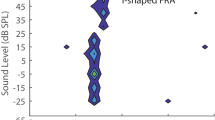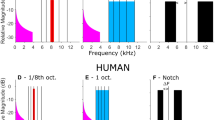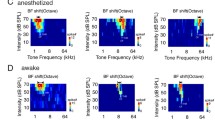Abstract
The tonotopicity of the cat's primary auditory cortex (AI) is thought to provide the framework for frequency-specific processing in that field. This study was designed to assess this postulate by examining the spatial distribution of neurons within AI that are activated by a single tonal frequency delivered to the contralateral ear. Distributions obtained at each of several stimulus levels were then compared to assess the influence of stimulus amplitude on the spatial representation of a given stimulus frequency in AI. Data were obtained from 308 single units in AI of four adult, barbiturate-anesthetized cats, using extracellular recording methods. Stimuli were 40-ms tone pulses presented through calibrated, sealed stimulating systems. In each animal, the CF (stimulus frequency to which the unit is most sensitive), threshold at CF, response/level function at CF, and binaural interactions were determined for isolated neurons (usually one per track) in 60–90 electrode tracks. For each unit, regardless of its CF, responses to 40 repetitions of contralateral tones of a single frequency, presented at each of four or five sound pressure levels (SPLs) in the range from 10 to 80 dB were obtained. Different test frequencies were used in each of four cats (1.6, 8.0, 11.0, and 16.0 kHz). For tones of each SPL, we generated maps of the response rates across the cortical surface. These maps were then superimposed on the more traditional maps of threshold CF. All units whose CF was equal to the test frequency could be driven at some SPL, given an appropriate monaural or binaural configuration of the stimulus. There was a clear spatial segregation of neurons according to the shapes of their CF tone response/level functions. Patches of cortex, often occupying more than 2 mm2, seemed to contain only monotonic or only nonmonotonic units. In three cortices, a patch of nonmonotonic cells was bounded ventrally by a patch of monotonie cells, and in one of these cases, a second patch of monotonic cells was found dorsal to the nonmonotonic patch. Contralateral tones of any given SPL evoked excitatory responses in discontinuous cortical territories. At low SPLs (10, 20 dB), small foci of activity occurred along the isofrequency line representing the test frequency. Many of these cells had nonmonotonic response/level functions. At mid- and high SPLs, the CFs of neurons activated by a pure tone varied across 3 octaves. At the highest SPL used (80 dB), most of the neurons with nonmonotonic response/level functions were inactive, or responded poorly; the active neurons were widely spread across the cortex, and the distribution of activity had a pattern bearing little relationship to the threshold CF contour map. These data indicate that only isolated patches of units within the relevant isofrequency contour are activated by a given suprathreshold contralateral tone. At suprathreshold stimulus levels, the region of cortex containing active patches extends widely beyond the threshold isofrequency contour region corresponding to the test stimulus frequency. The spatial representation of a stimulus delivered to the contralateral ear appears, therefore, to be highly level dependent and discontinuous. These observations suggest that in the cat's AI, tonotopicity and isofrequency contours are abstractions which bear little resemblance to the spatial representation of tonal signals.
Similar content being viewed by others
References
Aitkin LM, Merzenich MM, Irvine DRF, Clarey JC, Nelson JE (1986) Frequency representation in auditory cortex of the common marmoset (Callithrix jacchus jacchus). J Comp Neurol 252:175–185
Andersen RA, Knight PL, Merzenich MM (1980) The thalamocortical and corticothalamic connections of AI, AII and the anterior auditory field (AAF) in the cat: evidence for two largely segregated systems of connections. J Comp Neurol 194:663–701
Brandner S, Redies H (1990) The projection from medial geniculate to field AI in cat: organization in the isofrequency dimension. J Neurosci 10:50–61
Brugge JF, Dubrovsky NA, Aitkin LM, Anderson DJ (1969) Sensitivity of single neurons in auditory cortex of cat to binaural tonal stimulation; effects of varying interaural time and intensity. J Neurophysiol 32:1005–1024
Eggermont JJ (1991) Rate and synchronization measures of periodicity coding in cat primary auditory cortex. Hear Res 56:153–167
Eggermont JJ (1992) Neural interaction in cat primary auditory cortex. Dependence on recording depth, electrode separation, and age. J Neurophysiol 68:1216–1228
Evans EF (1975) Normal and abnormal functioning of the cochlear nerve. Symp Zool Soc (Lond) 37:133–165
Imig TJ, Adrian HO (1977) Binaural columns in the primary field (AI) of cat auditory cortex. Brain Res 138:241–257
Imig TJ, Brugge JF (1978) Sources and terminations of callosal axons related to binaural and frequency maps in primary auditory cortex of the cat. J Comp Neurol 182:637–660
Imig TJ, Reale RA (1981) Ipsilateral corticocortical projections related to binaural columns in cat primary auditory cortex. JComp Neurol 203:1–14
Imig TJ, Ruggero MA, Kitzes LM, Javel E, Brugge JF (1977) Organization of auditory cortex in the owl monkey (Aotus trivirgatus). J Comp Neurol 171:111–128
Imig TJ, Irons WA, Samson FR (1990) Single-unit selectivity to azimuthal direction and sound pressure level of noise bursts in cat high-frequency primary auditory cortex. J Neurophysiol 63:1448–1466
Jenkins WM, Merzenich MM (1984) Role of cat primary auditory cortex for sound localization behavior. J Neurophysiol 52:819–847
Kelly JB, Judge PW, Phillips DP (1986) Representation of the cochlea in primary auditory cortex of the ferret (Mustela putorius). Hear Res 24:111–116
Kim DO, Molnar CE (1979) A population study of cochlear nerve fibers: comparison of spatial distributions of average-rate and phase-locking measures of responses to single tones. J Neurophysiol 42:16–30
Kim DO, Parham K (1991) Auditory nerve spatial encoding of high-frequency pure tones: population response profiles derived from d' measure associated with nearby places along the cochlea. Hear Res 52:167–180
Kim DO, Chang SO, Sirianni JG (1990) A population study of auditory nerve-fibers in unanesthetized decerebrate cats: responses to pure tones. J Acoust Soc Am 87:1648–1655
Kitzes LM, Wrege KS, Cassady JM (1980) Patterns of responses of cortical cells to binaural stimulation. J Comp Neurol 192:455–472
Kniight PL (1977) Representation of the cochlea within the anterior auditory field (AAF) of the cat. Brain Res 130:447–467
Matsubara JA, Phillips DP (1988) Intracortical connections and their physiological correlates in the primary auditory cortex (AI) of the cat. J Comp Neurol 268:38–48
Merzenich MM, Brugge JF (1973) Representation of the cochlear partition on the superior temporal plane of the macaque monkey. Brain Res 50:275–296
Merzenich MM, Knight PL, Roth GL (1975) Representation of cochlea within primary auditory cortex in the cat. J Neurophysiol 38:231–249
Merzenich MM, Kaas JH, Roth GL (1976) Auditory cortex in the grey squirrel: tonotopic organization and architectonic fields. J Comp Neurol 166:387–402
Middlebrooks JC, Zook JM (1983) Intrinsic organization of the cat's medial geniculate body identified by projections to binaural response-specific bands in the primary auditory cortex. J Neurosci 3:203–224
Middlebrooks JC, Dykes RW, Merzenich MM (1980) Binaural response-specific bands in primary auditory cortex (AI) of the cat: topographic organization orthogonal to isofrequency contours. Brain Res 181:31–48
Moore BCJ (1989) An introduction to the psychology of hearing, 3rd edn. Academic, London
Morel A, Imig TJ (1987) Thalamic projections to fields A, AI, P, and VP in the cat auditory cortex. J Comp Neurol 265:119–144
Pfeiffer RR, Kim DO (1975) Cochlear nerve fiber responses: distribution along the cochlear partition. J Acoust Soc Am 58:867–869
Phillips DP (1987) Stimulus intensity and loudness recruitment: neural correlates. J Acoust Soc Am 82:1–12
Phillips DP (1988) Effect of tone-pulse rise time on rate-level functions of cat auditory cortex neurons: excitatory and inhibitory processes shaping responses to tone onset. J Neurophysiol 59:1524–1539
Phillips DP (1990) Neural representation of sound amplitude in the auditory cortex: effects of noise masking. Behav Brain Res 37:197–214
Phillips DP (1993a) Neural representation of stimulus times in the rimary auditory cortex. Ann NY Acad Sci 682:104–118
Phillips DP (1993b) Representation of acoustic events in the primary auditory cortex. J Exp Psychol Hum Percept Perf 19:203–216
Phillips DP, Cynader MS (1985) Some neural mechanisms in the cat's auditory cortex underlying sensitivity to combined tone and wide-spectrum noise stimuli. Hear Res 18:87–102
Phillips DP, Hall SE (1990) Response timing constraints on the cortical representation of sound time structure. J Acoust Soc Am 88:1403–1411
Phillips DP, Hall SE (1992) Multiplicity of inputs in the afferent path to cat primary auditory cortex neurons revealed by toneon-tone masking. Cereb Cortex 2:425–433
Phillips DP, Irvine DRF (1979) Methodological considerations in mapping auditory cortex: binaural columns in AI of cat. Brain Res 161:342–346
Phillips DP, Irvine DRF (1981) Responses of single neurons in physiologically defined primary auditory cortex (AI) of the cat: frequency tuning and responses to intensity. J Neurophysiol 45:48–58
Phillips DP, Irvine DRF (1983) Some features of the binaural input to single neurons in physiologically defined area AI of cat cerebral cortex. J Neurophysiol 49:383–395
Phillips DP, Orman SS, Musicant AD, Wilson GF (1985) Neurons in the cat's primary auditory cortex distinguished by their responses to tones and wide-spectrum noise. Hear Res 18:73–86
Reale RA, Brugge JF (1990) Auditory cortical neurons are sensitive to static and continuously changing interaural phase cues. J Neurophysiol 64:1247–1260
Reale RA, Imig TJ (1980) Tonotopic organization in auditory cortex of the cat. J Comp Neurol 192:265–291
Reale RA, Kettner RE (1986) Topography of binaural organization in primary auditory cortex of the cat: effects of changing interaural intensity. J Neurophysiol 56:663–682
Redies H, Sieben U, Creutzfeldt OD (1989) Functional subdivisions in the auditory cortex of the guinea pig. J Comp Neurol 282:473–488
Rose JE, Brugge JF, Anderson DJ, Hind JE (1967) Phase-locked response to low-frequency tones in single auditory nerve fibers of the squirrel monkey. J Neurophysiol 30:769–793
Rouiller EM, Simm GM, Villa AEP, Ribaupierre Y de, Ribaupierre F de (1991) Auditory corticocortical interconnections in the cat: evidence for parallel and heirarchical arrangement of the auditory cortical areas. Exp Brain Res 86:483–505
Sachs MB, Young ED (1979) Encoding of steady-state vowels in the auditory nerve: representation in terms of discharge rate. J Acoust Soc Am 66:470–479
Sally SL, Kelly JB (1988) Organization of auditory cortex in the albino rat: sound frequency. J Neurophysiol 59:1627–1638
Schreiner CE, Cynader MS (1984) Basic functional organization of the second auditory cortical field (AII) of the cat. J Neurophysiol 51:1284–1305
Schreiner CE, Mendelson JR (1990) Functional topography of cat primary auditory cortex: distribution of integrated excitation. J Neurophysiol 64:1442–1459
Schreiner CE, Mendelson JR, Sutler ML (1992) Functional topography of cat primary auditory cortex: representation of tone intensity. Exp Brain Res 92:105–122
Semple MN, Kitzes LM (1987) Binaural processing of sound pressure level in the inferior colliculus. J Neurophysiol 57:1130–1147
Semple MN, Kitzes LM (1993a) Binaural processing of sound pressure level in cat primary auditory cortex: evidence for a representation based on absolute levels rather than interaural level differences. J Neurophysiol 69:449–461
Semple MN, Kitzes LM (1993b) Focal selectivity for binaural sound pressure level in cat primary auditory cortex: two-way intensity network (TWIN) tuning. J Neurophysiol 69:462–473
Shamma SA, Symmes D (1985) Patterns of inhibition in auditory cortical cells in awake squirrel monkeys. Hear Res 19:1–13
Uno H, Murai N, Fukunishi K (1993) The tonotopic representation in the auditory cortex of the guinea pig with optical recording. Neurosci Lett 150:179–182
Wallace MN, Kitzes LM, Jones EG (1991) Intrinsic inter- and intralaminar connections and their relationship to the tonotopic map in cat primary auditory cortex. Exp Brain Res 86:527–544
Young ED, Sachs MB (1979) Representation of steady-state vowels in the temporal aspects of the discharge patterns of populations of auditory-nerve fibers. J Acoust Soc Am 66:1381–1403
Author information
Authors and Affiliations
Additional information
On leave from: Departments of Psychology and Otolaryngology, Dalhousie University, Halifax, NS, Canada B3H 4J1
On leave from: Vision, Touch and Hearing Research Center, Department of Physiology and Pharmacology, The University of Queensland, Brisbane, Q1d, Australia 4072
Rights and permissions
About this article
Cite this article
Phillips, D.P., Semple, M.N., Calford, M.B. et al. Level-dependent representation of stimulus frequency in cat primary auditory cortex. Exp Brain Res 102, 210–226 (1994). https://doi.org/10.1007/BF00227510
Received:
Accepted:
Issue Date:
DOI: https://doi.org/10.1007/BF00227510




